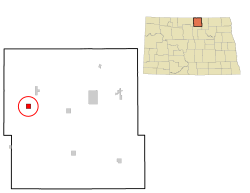Dunseith, North Dakota facts for kids
Quick facts for kids
Dunseith, North Dakota
|
|
|---|---|
 |
|

Location of Dunseith, North Dakota
|
|
| Country | United States |
| State | North Dakota |
| County | Rolette |
| Founded | 1882 |
| Incorporated | 1908 |
| Named for | Jeannette Dunseith Eaton |
| Area | |
| • Total | 1.00 sq mi (2.59 km2) |
| • Land | 1.00 sq mi (2.59 km2) |
| • Water | 0.00 sq mi (0.00 km2) |
| Elevation | 1,706 ft (520 m) |
| Population
(2020)
|
|
| • Total | 632 |
| • Estimate
(2022)
|
622 |
| • Density | 630.74/sq mi (243.59/km2) |
| Time zone | UTC-6 (Central (CST)) |
| • Summer (DST) | UTC-5 (CDT) |
| ZIP code |
58329
|
| Area code(s) | 701 |
| FIPS code | 38-21020 |
| GNIS feature ID | 1036000 |
Dunseith (/dʌnˈsiːθ/ dun-SEETH) is a city in Rolette County, North Dakota, United States. The population was 632 at the 2020 census. Dunseith is best known for its proximity to the International Peace Garden. The port of entry at the Peace Garden is one of three 24-hour ports in North Dakota (the others being Portal and Pembina). Dunseith is also the home of the world's largest turtle sculpture, the "W'eel Turtle", made of more than 2,000 wheels painted green.
Contents
History
Dunseith was platted in 1882. The town was founded by William Dunseith Eaton of Chicago in 1884. A post office has been in operation in Dunseith since 1884. The city was incorporated in 1908.
Geography
According to the United States Census Bureau, the city has a total area of 1.00 square mile (2.59 km2), all land. Dunseith lies just south of the Turtle Mountain plateau.
Demographics
| Historical population | |||
|---|---|---|---|
| Census | Pop. | %± | |
| 1910 | 473 | — | |
| 1920 | 374 | −20.9% | |
| 1930 | 484 | 29.4% | |
| 1940 | 719 | 48.6% | |
| 1950 | 713 | −0.8% | |
| 1960 | 1,017 | 42.6% | |
| 1970 | 811 | −20.3% | |
| 1980 | 625 | −22.9% | |
| 1990 | 723 | 15.7% | |
| 2000 | 739 | 2.2% | |
| 2010 | 773 | 4.6% | |
| 2020 | 632 | −18.2% | |
| 2022 (est.) | 622 | −19.5% | |
| U.S. Decennial Census 2020 Census |
|||
2010 census
As of the census of 2010, there were 773 people, 274 households, and 170 families residing in the city. The population density was 773.0 inhabitants per square mile (298.5/km2). There were 299 housing units at an average density of 299.0 per square mile (115.4/km2). The racial makeup of the city was 15.0% White, 0.9% African American, 79.6% Native American, 0.4% from other races, and 4.1% from two or more races. Hispanic or Latino of any race were 2.2% of the population.
There were 274 households, of which 46.4% had children under the age of 18 living with them, 27.4% were married couples living together, 25.2% had a female householder with no husband present, 9.5% had a male householder with no wife present, and 38.0% were non-families. 32.1% of all households were made up of individuals, and 12% had someone living alone who was 65 years of age or older. The average household size was 2.72 and the average family size was 3.41.
The median age in the city was 27.4 years. 35.8% of residents were under the age of 18; 10.2% were between the ages of 18 and 24; 23.7% were from 25 to 44; 18.2% were from 45 to 64; and 12.2% were 65 years of age or older. The gender makeup of the city was 49.2% male and 50.8% female.
Climate
This climatic region is typified by large seasonal temperature differences, with warm to hot (and often humid) summers and cold (sometimes severely cold) winters. According to the Köppen Climate Classification system, Dunseith has a humid continental climate, abbreviated "Dfb" on climate maps.
See also
 In Spanish: Dunseith (Dakota del Norte) para niños
In Spanish: Dunseith (Dakota del Norte) para niños

